JANUARY 30, 2024: Our first evening at a campground was spent unpacking, putting everything away and getting organized and comfortable in the motorhome. What fun. Our many suitcases were full because we came very well prepared – I have a checklist made over the years of everything we might need. Not everyone knows to bring a fly swatter with them.
Not having scheduled each day in advance, the plan for this trip was that in the evenings we would plan a day or two ahead. This turned out to be not such a good idea. Researching where to go and what to do became very challenging because many campgrounds do not have internet. If there was cell phone coverage, it was usually very weak – barely enough to use a browser on the phone and definitely not enough to hot-spot a computer. My usual planning everything ahead was looking even better.
In the morning, as we were about to leave the campground, I noticed a park ranger standing on the side as though ready to lead a walk. Sure enough, she was waiting for someone to do a nature hike with her this morning. We decided to go along. Soon we were joined by one other couple and an additional park ranger and began what became a very enjoyable two-hour walk to learn about the different plants and animals in the area. I saw there are some advantages to spontaneity.

On the walk, we saw many different types of cacti, including the prickly pear. According to the park ranger, the prickly pear cactus is native to this region, and is an import to all the other places where it grows, including Israel.


The focus of the walk was on the Saguaro – the tall cactuses that dominate the landscape here. They live to over 200 years and as they age, some develop arms, while others do not. It is not really understood why. On the outside of the cacti are ribs that contract and expand depending on the amount of moisture the cactus has captured. Different types of birds, burrow holes in the saguaro to build nests. Towards the bottom of the cacti, where the ridges are large and hardest, a Gila Woodpecker that can withstand hard knocking, will create a hole there for its nest. Towards the top of the cactus where the ridges are softer, a Gilded Flicker bird will build its nest. These birds use their nests for one year, and then other birds, such as owls will move in. So interesting to learn how in nature every plant and every animal has a role to play and how they depend on each other.
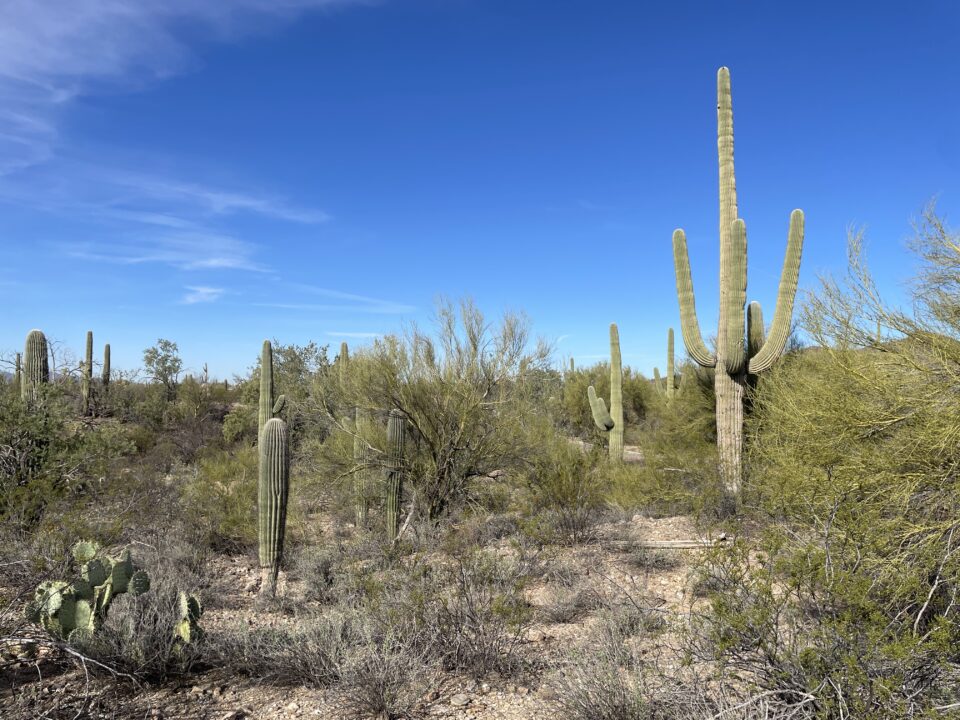
What we see aboveground of a Saguaro is the tall column of the cactus, but underground it has many roots that spread out over a wide distance (usually as far as the cactus is tall) and which are located about three inches under the surface. These roots capture the rains that occasionally occur (summer rains are short and strong, while winter rains are long and light) and the moisture is then turned into a gel that is stored in the ridges of the cactus.

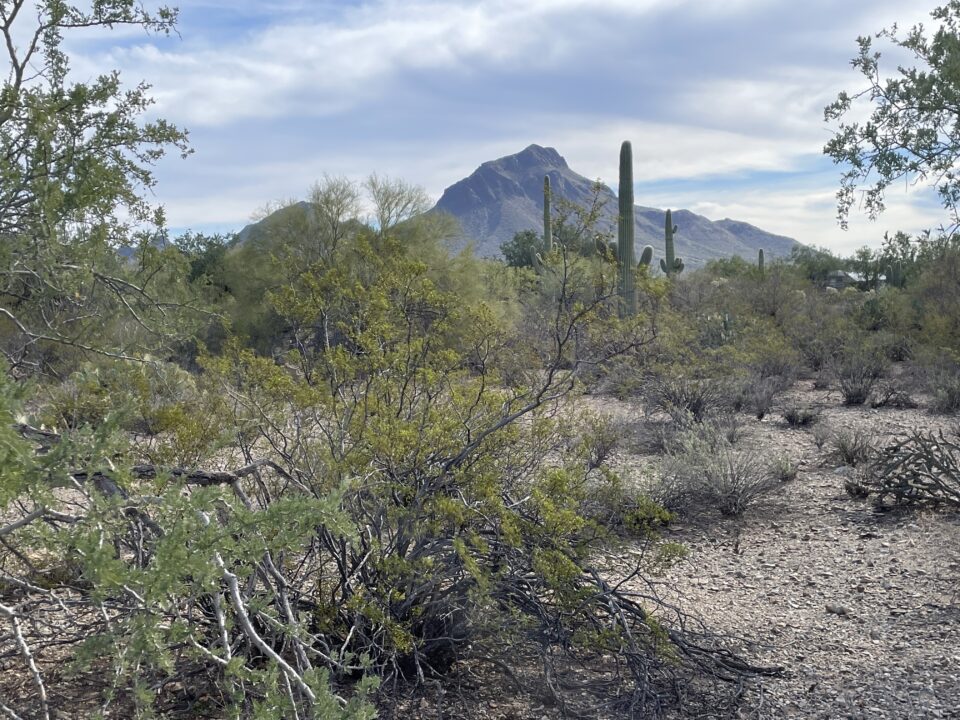
All the cacti have beautiful flowers, usually that bloom for a very short time in summer. One cactus, the barrel cactus, still had yellow fruit on top. The fruit of this cactus takes months to ripen, and that is why it was still visible now at the end of January.
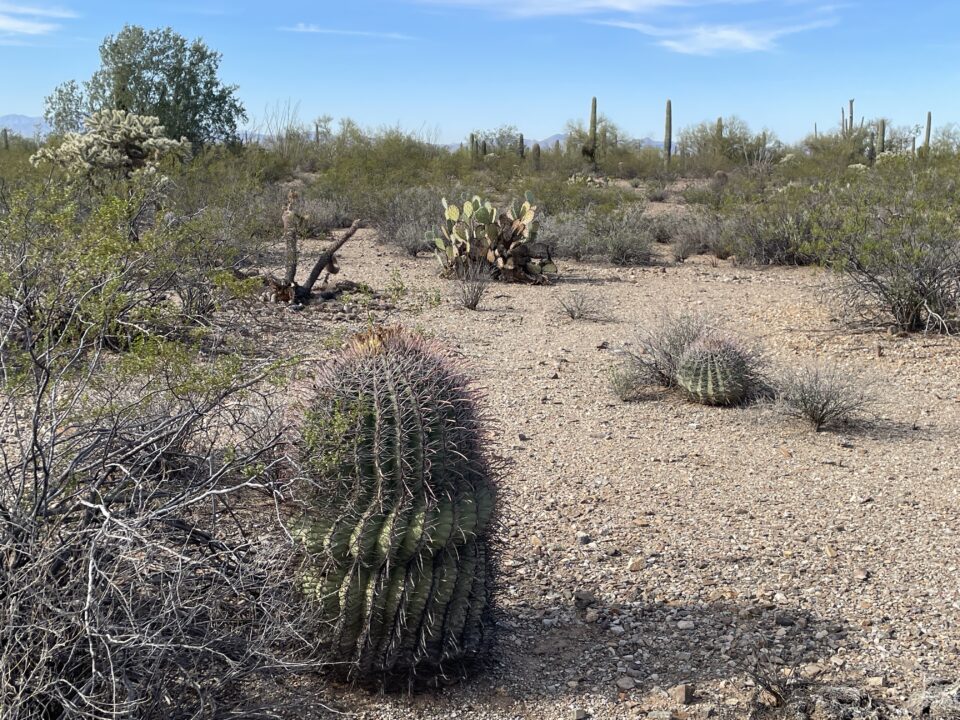
We also learned that in John Wayne movies, they once lied. In one of his movies, the cowboy is abandoned in the desert and is parched from thirst. He finds a barrel cactus, cuts its top off, and scoops out water to drink. In reality, there is no drinking water inside the barrel cactus. Hollywood took a cactus, cut it in half, placed a bowl of water inside, and replaced the top. Everything else about John Wayne movies is true.
What the cowboy should have done, and would have been true to reality, is eat the seeds inside the pods growing on the desert trees. We saw three different types of trees that grow in the area – Palo Verde, Ironweed and Mesquite – all with edible seeds.
Scattered throughout the walk, the park ranger pointed out several pack rat homes. These are large, spread-out piles of dead cactus parts, full of tunnels and designated rooms. One room, for example, will be the pantry, where the mother rat stores food for her family. A mother rat will build this home for herself and her children, and eventually one of her daughter rats will inherit the place. Snakes, who like the tunnels, sometimes will co-inhabit with them, until they get hungry and eat the baby rats.
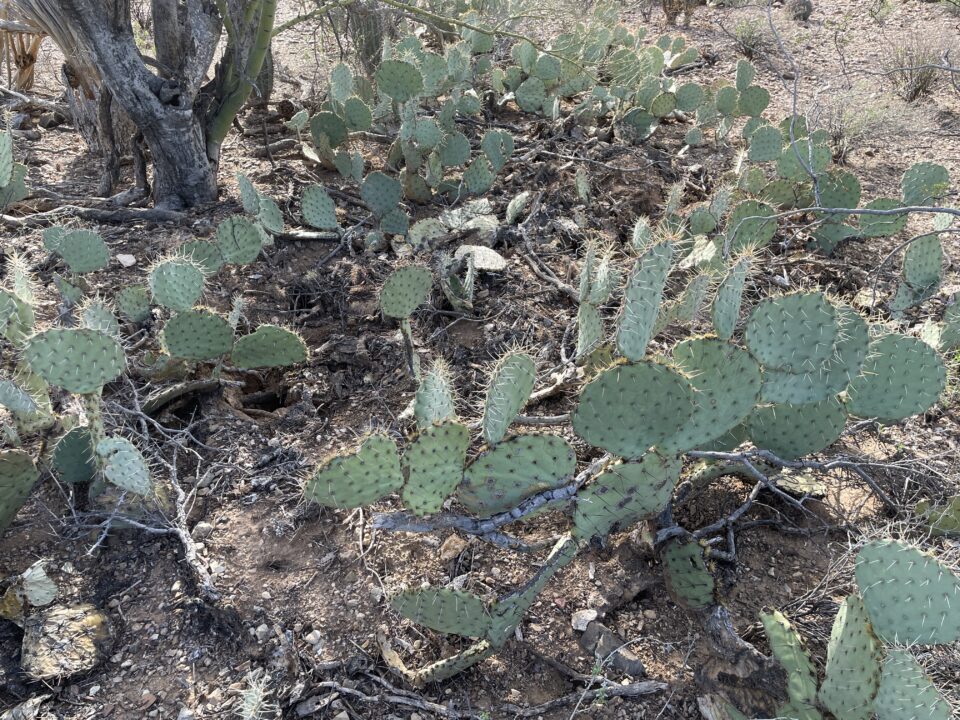
We learned that the night before it would have been good to leave a lantern light under the motorhome. Pack rats do not like lights. The hood of the car should also have been kept open. The rats do not feel secure in open spaces. If not, you might wake up in the morning to discover that the insulation on your electric cables has made a tasty meal for the rats and you can no longer turn on the engine. Lucky that nothing happened this time. Good to know for next time.
Another cactus that appears frequently in the park is the tree-like Jumping Cholla. The “jumping cholla” name comes from the ease with which the stems detach. Often the merest touch will leave a person with bits of cactus hanging on their clothes. The park ranger carried a comb to help detach the cholla pieces from our jackets and she needed to use it several times during the walk.
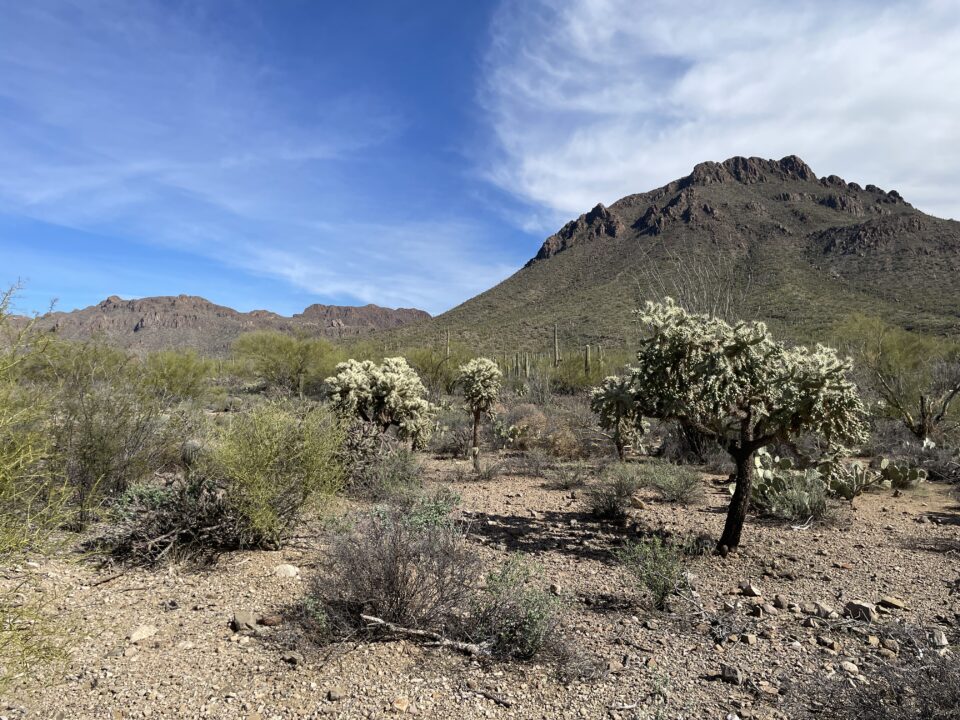
The Tucson Mountain Park is the largest county park in the USA (county as opposed to state or national park). It is now about 20,000 acres. It used to be double the size, but the northern 20,000 acres were turned into the Saguaro National Park in 1961. This was done because at the time, it was thought that the Saguaro cacti were dying, and as a National Park, the federal government would have a larger budget to help remedy the situation.
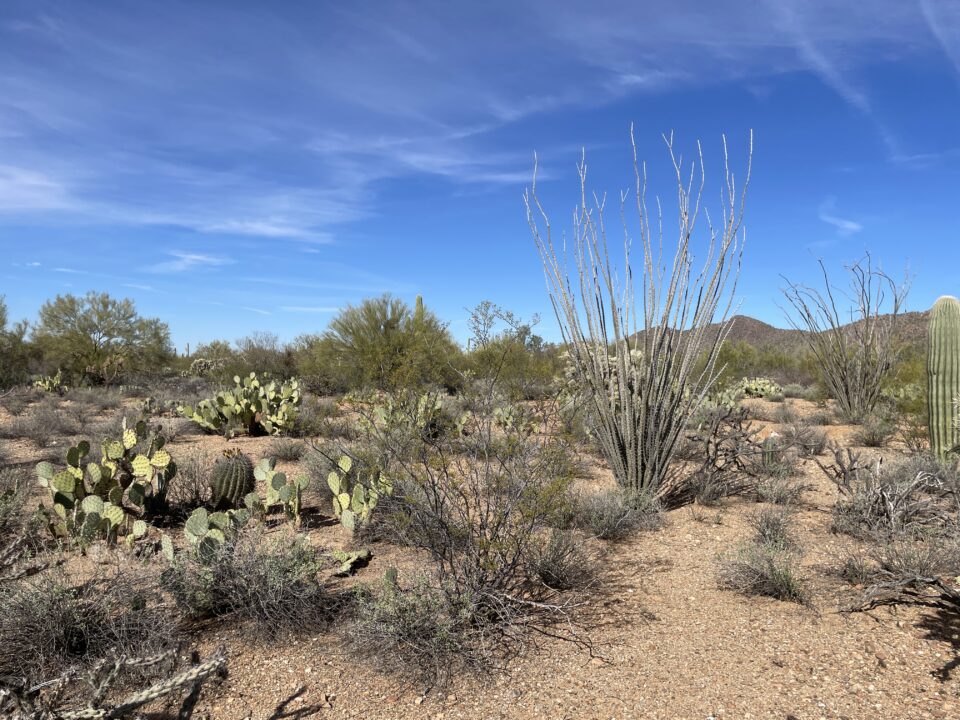

We were supposed to return to Saguaro National Park this morning but had taken the nature hike in the Tucson Mountain Park instead. It was now close to noon, and it was time to move onward to Tucson to see a couple of Jewish Heritage sites for Wandering Jew.
Tucson is similar to Phoenix in that it lies in a mostly flat valley surrounded by beautiful mountains. Desert landscaping prevails. Phoenix, however, is much more manicured. Tucson feels like a wilder, more natural version of Phoenix.
Our first stop in Tucson was the Tucson Jewish Museum & Holocaust Center. Unfortunately, it is closed on Mondays and Tuesdays, and today was Tuesday. The complex is located in an historic neighborhood on the southern edge of downtown Tucson. The museum is housed in what was once Temple Emanuel, the first synagogue built in Arizona. It opened in 1910 and was used for worship until 1949. Today the museum displays exhibits about Southern Arizona Jewish history and the contribution of the Jews to the development and growth of Tucson. The Holocaust History Center, in a new building next door, aims to educate about the Holocaust and other genocides.
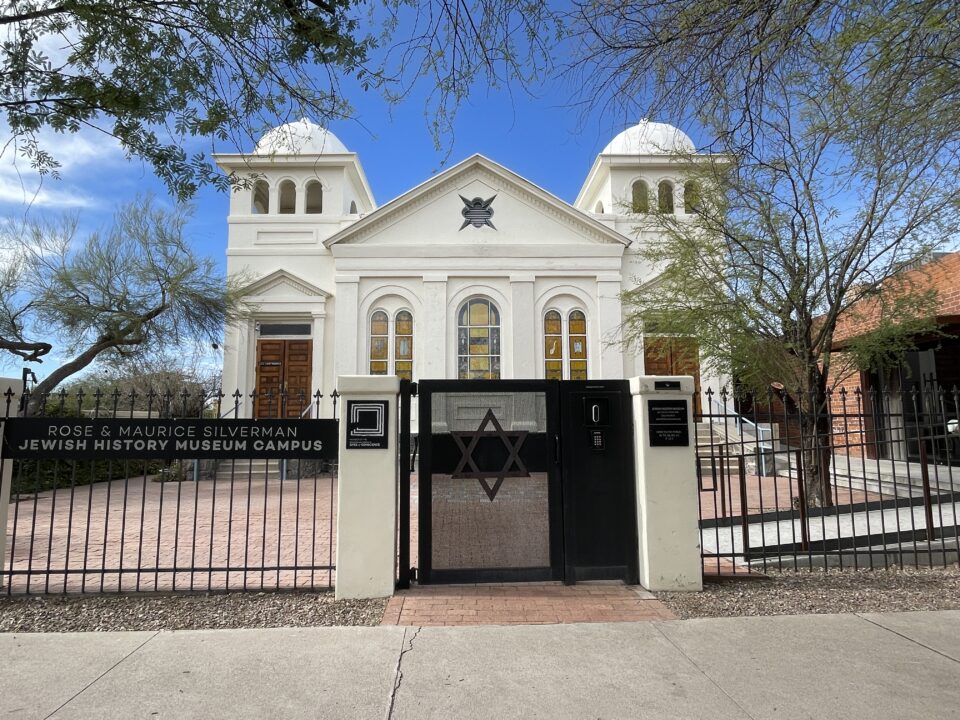

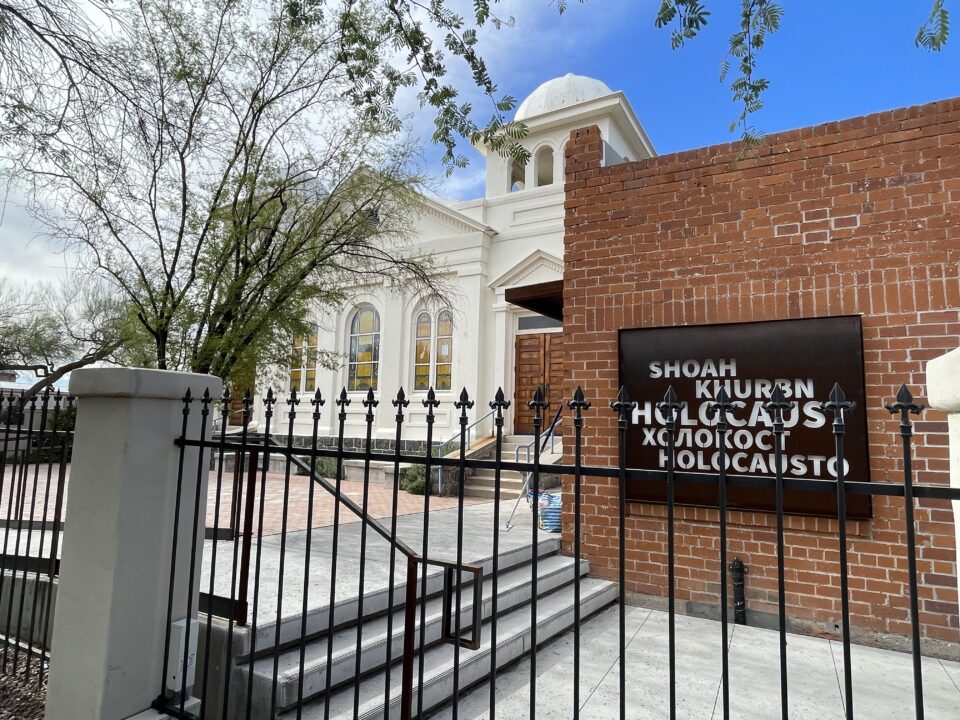
On the boundary wall of museum, we saw many ceramic butterflies. This was part of the Butterfly Project which aims to have 1.5 million ceramic butterflies displayed worldwide as a memorial to the same number of children who perished in the Holocaust. The project was inspired by a poem written by Pavel Friedmann in 1942, when he was a prisoner in the Terezin Concentration Camp in the Czech Republic. His poem ends with the lines “Only I never saw another butterfly. That butterfly was the last one. Butterflies don’t live in here, in the ghetto.” In 1944, Pavel was deported to Auschwitz, where he was murdered. His poems were discovered after the end of the war. The butterflies, with their story of rebirth and transformation into new life, are displayed as symbols of resilience and hope.

From the Jewish Museum, we drove to the Tucson Jewish Community Center. The Tucson JCC is a huge 98,000-square-feet modern building built in 1989. At the entrance to the building, and the reason for our visit, is a very large, very impressive Holocaust Memorial. It was created by the Israeli artist Ami Shamir. At the center of the monument is a large concrete tablet reminiscent of the Ten Commandments, but instead of commandments, it is inscribed with 150 names of death camps, concentration camps, and ghettos where atrocities took place.
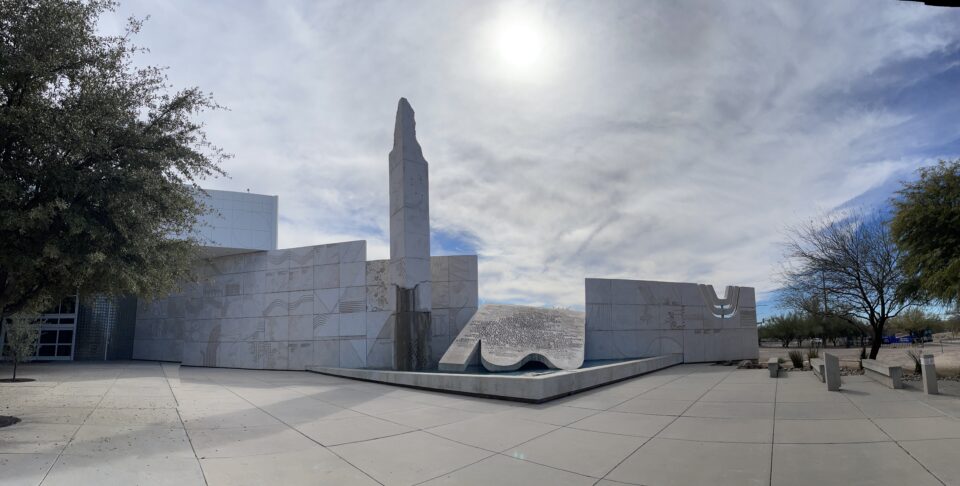
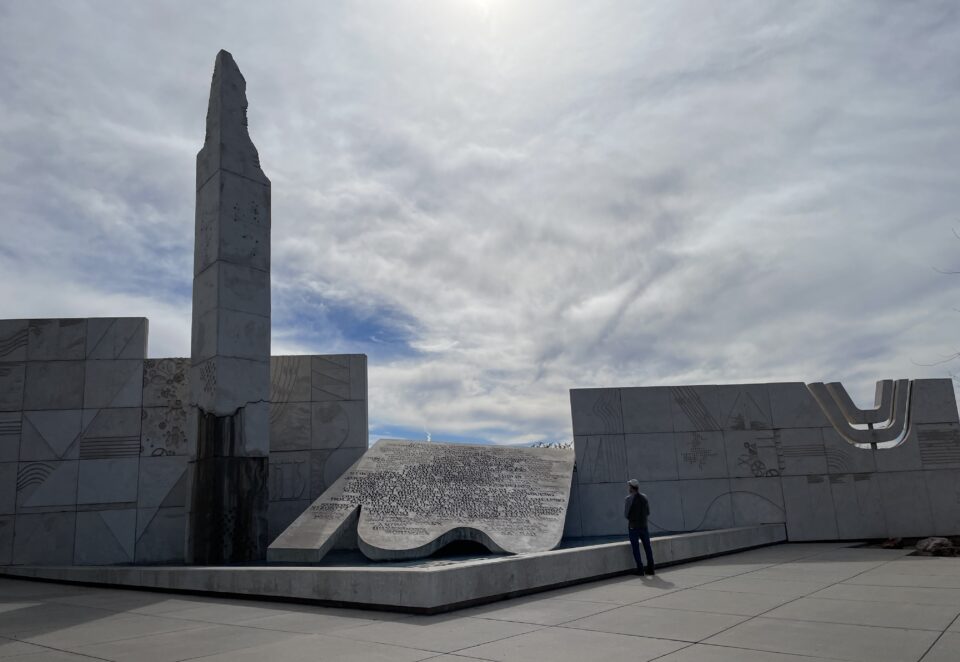
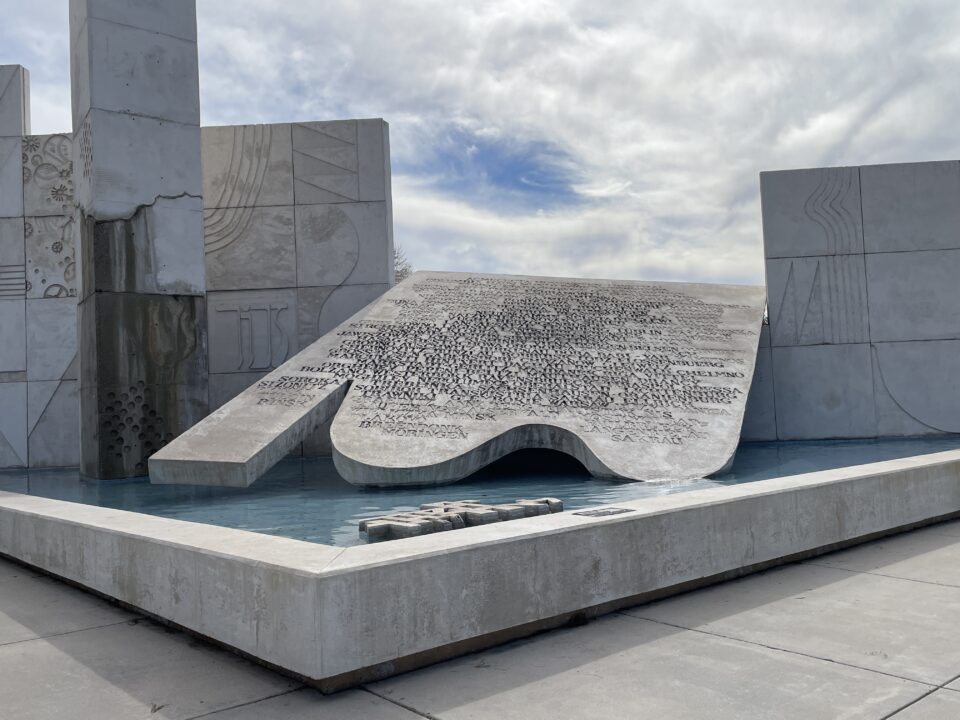
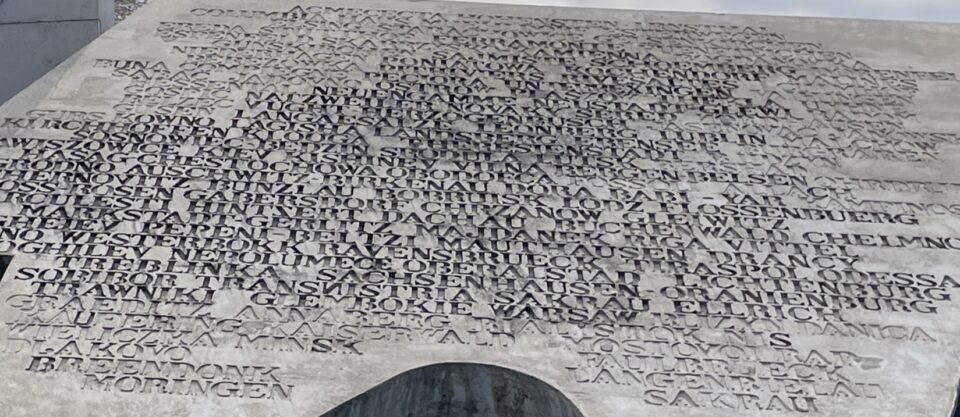
Next to the tablet, a column rises from the reflecting pool and is shattered at its peak, as was Jewish society throughout Europe. Water weeps from a crack in the side of the column and runs down into the pool. In the pool, water flows and supports the Hebrew letters that spell, “There is hope for thy future.”
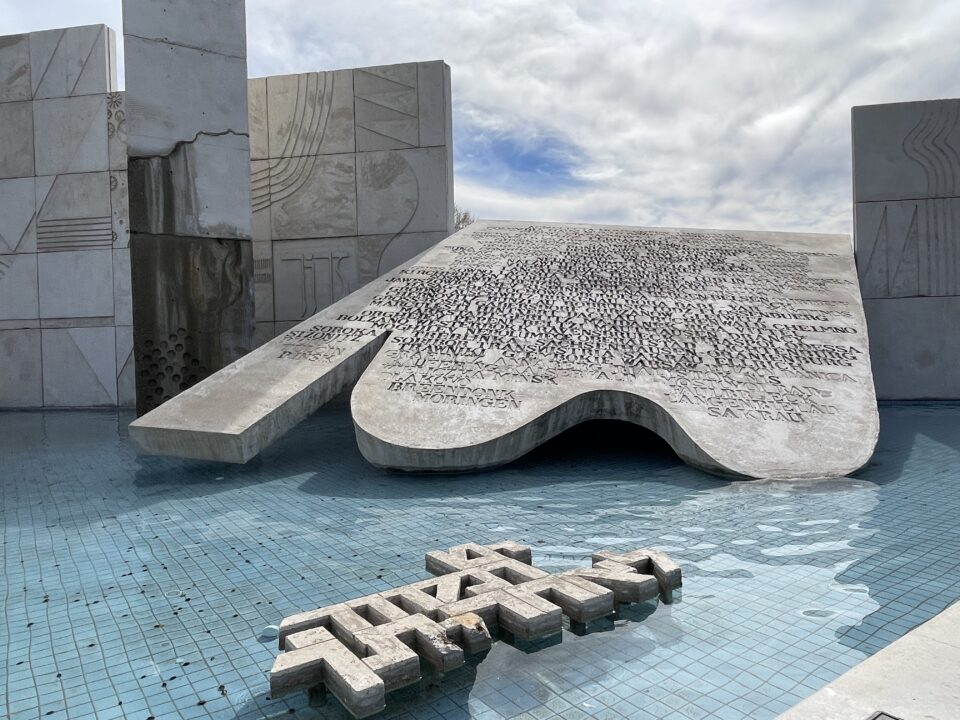
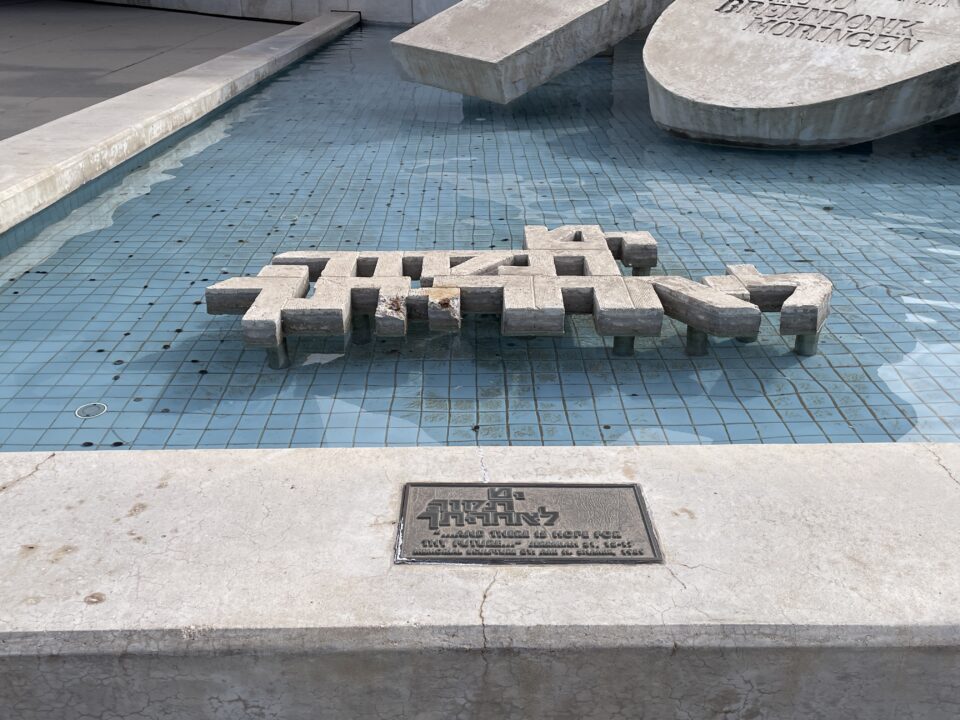
In addition, a large, concrete wall behind the tablet and column, shows abstract images of train tracks, gears of industry, the Star of David, a menorah, and the Hebrew words zachor (remember) and Y’srael. A very powerful display.
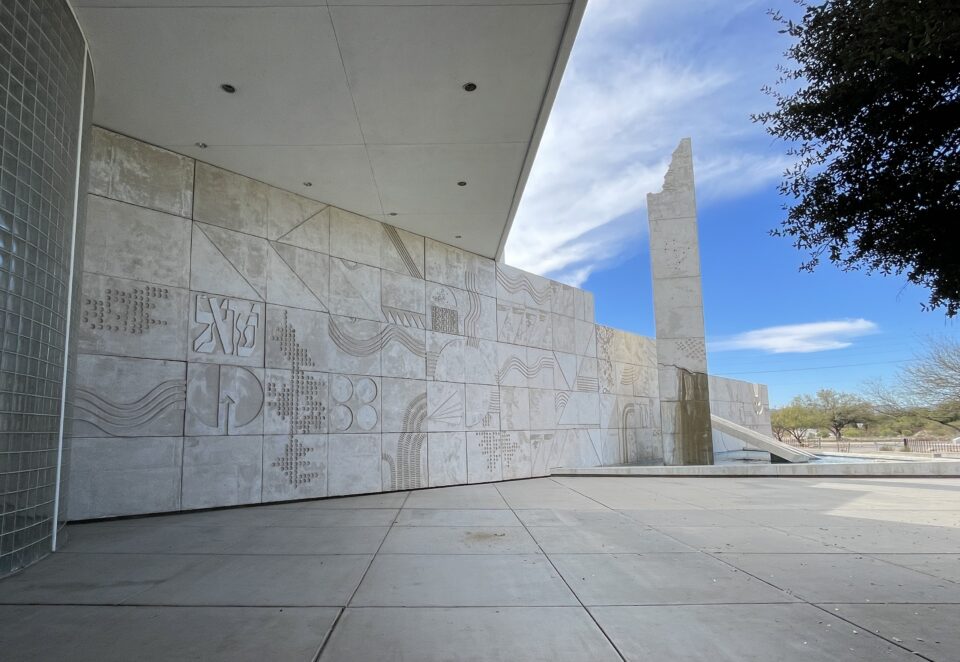
The JCC has over 5000 members and as we entered the building, we saw that it was bustling with activity – many people participating in its wide range of programs. We noticed that a Jewish Film Festival was taking place this week and was all sold out. It felt good to see several displays in support of Israel in the current war. We even found a few ceramic butterflies – a continuation of the Butterfly Project. The JCC also has the only kosher restaurant in Tucson, and we enjoyed a simple lunch there.
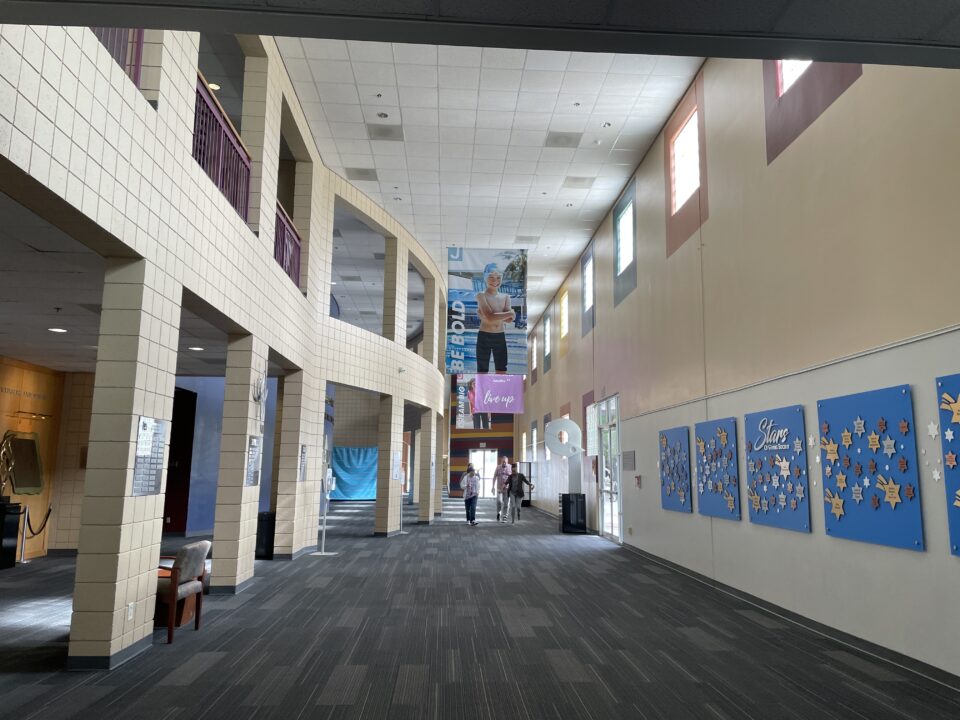
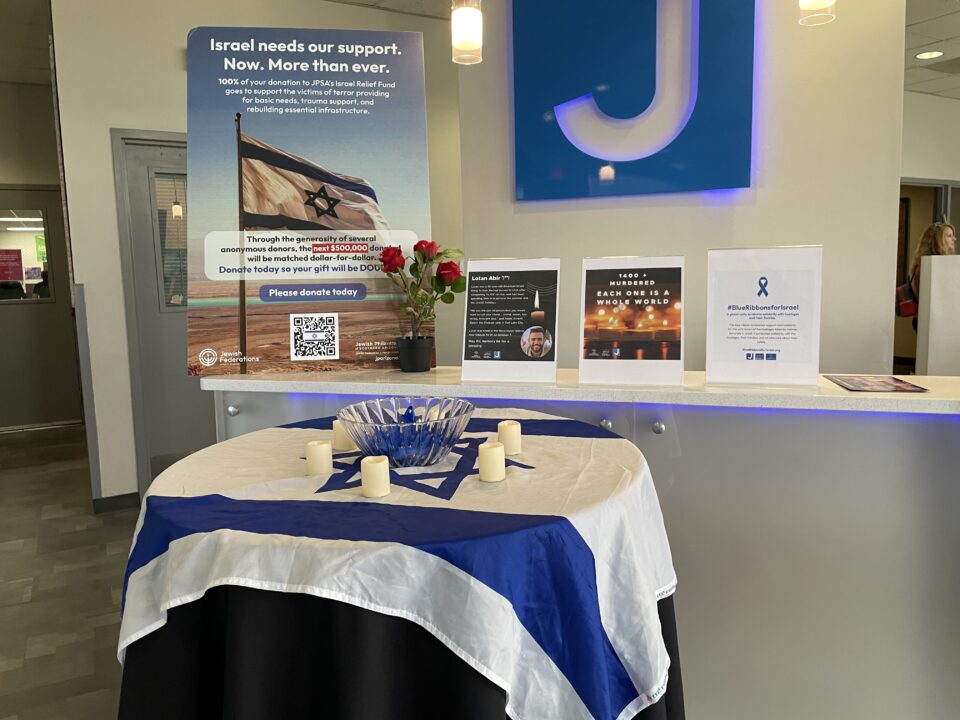
We still had a couple of hours before dark, and decided instead of staying in Tucson, we would start the drive towards Nogales, a small city on the border with Mexico.
On the way there, we noticed that the road signs started showing kilometers instead of miles. We were still in the USA – why kilometers? Personally, I prefer kilometers – they pass much quicker than miles when traveling, so it was a welcome change. We later learned that many years ago, just as they were replacing the signage on this section of the highway, there was talk to convert all of the USA to the metric system. The people responsible for the signs wanted to be early adopters of the new way. The conversion to metric never took place, but these highway signs remain.
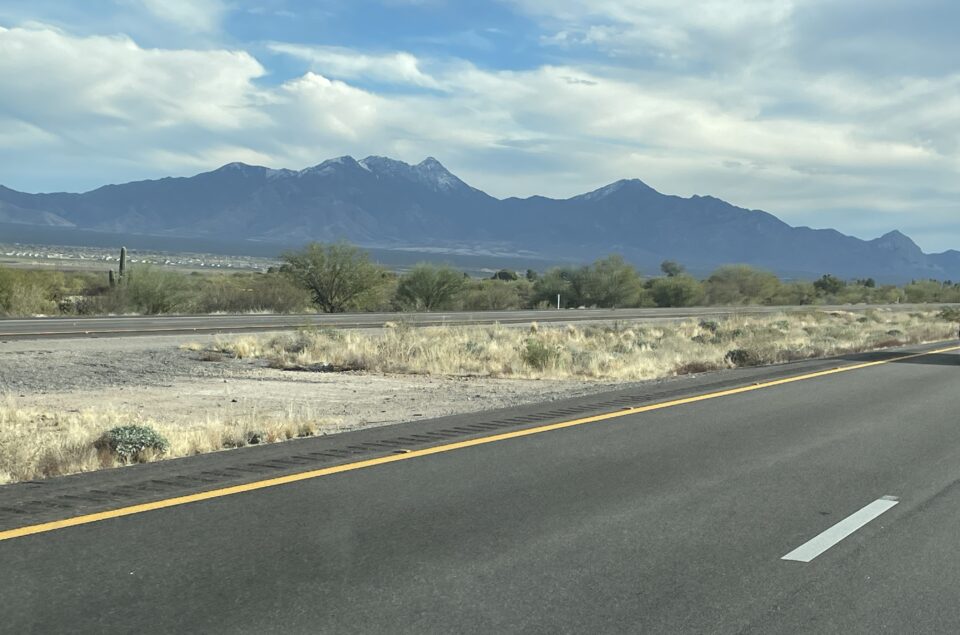
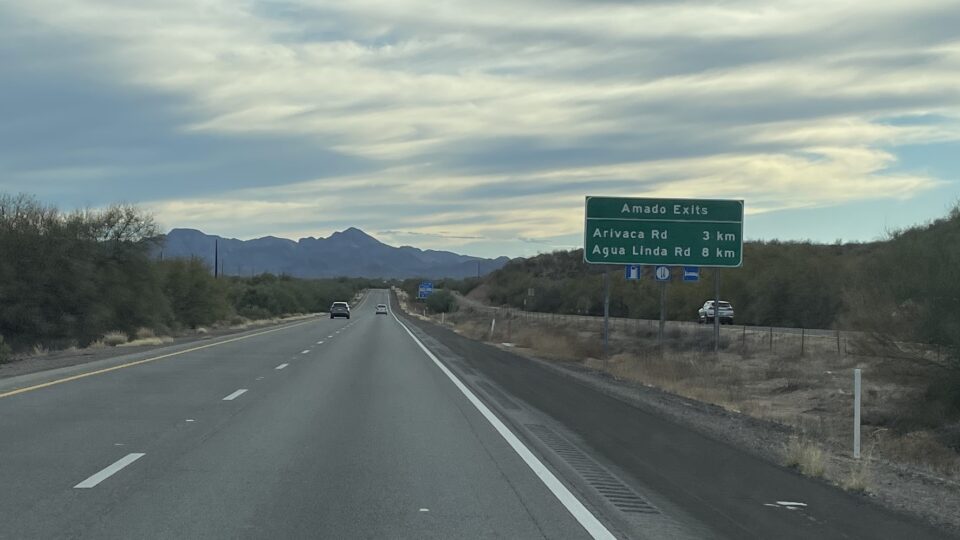
We selected a campground for the night. The place was more properly known as an RV resort. The registration office was known as the clubhouse. This resort was a place where people park huge motorhomes or trailers (much longer than ours and many with sides that expand) and stay for an extended time, not for just one night like us. Next to their entrance door, they place outdoor carpets, potted plants, barbeque grills, lounge chairs, etc. They make it more of a home. The clubhouse has a daily list of activities in addition to the pool, exercise room and golf course on the grounds. Next to each motorhome is a car they towed and now use for daily travel.
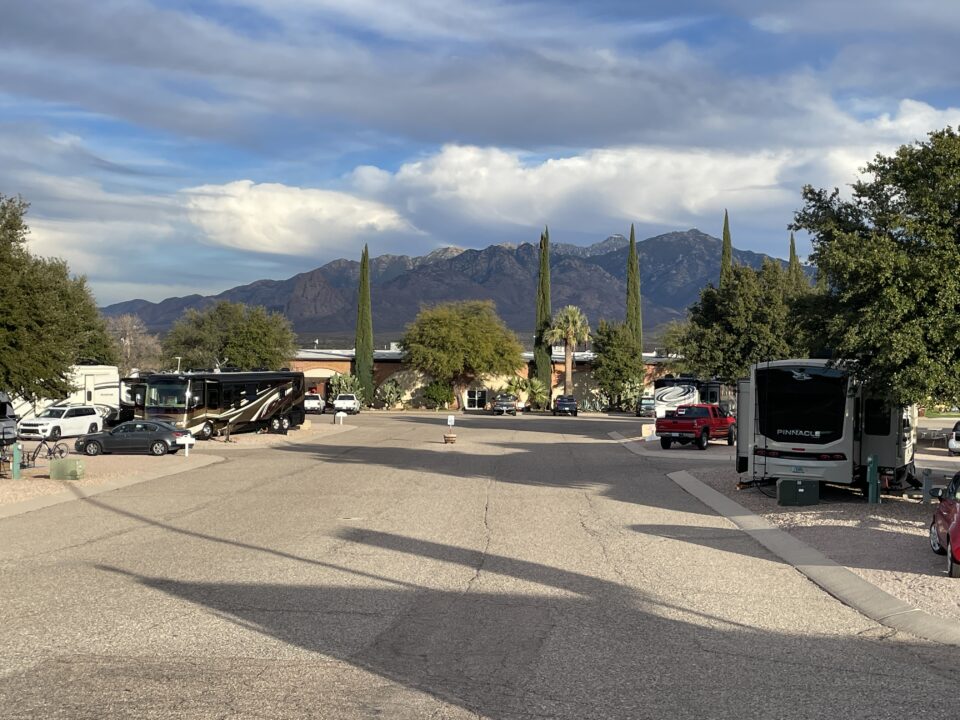
When we reached the campground, there was a cactus garden in front of the registration office. In this morning’s nature hike, there were two topics the park ranger talked about that we did not see in the park. The first was about the cochineal, an insect that lives on the prickly pear cactus and leaves a white covering on the cactus leaves. A brilliant red dye is extracted from the crushed bodies of the cochineal bugs. The British used this dye in their clothes (redcoats) and today it is still used in food coloring and lipsticks. Here, in front of the clubhouse was a prickly pear cactus covered with white, just as the park ranger described it.
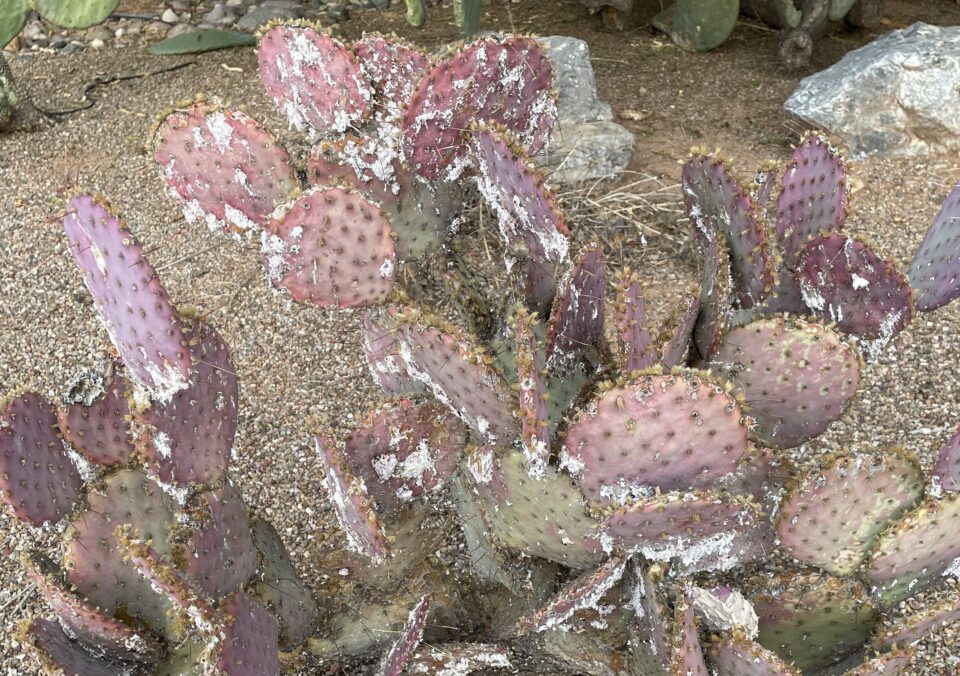
The other topic the park ranger talked about was crested cacti. These are cacti that looked like broccoli was growing out of their top. We did not see one on the tour, and I could not really imagine what one looked like, but here in front of our parking space at the registration office was something that could be nothing else. Crested cacti happens when the single growing point of a cactus plant is either damaged or mutated and the cacti begins to grow in multiple places.
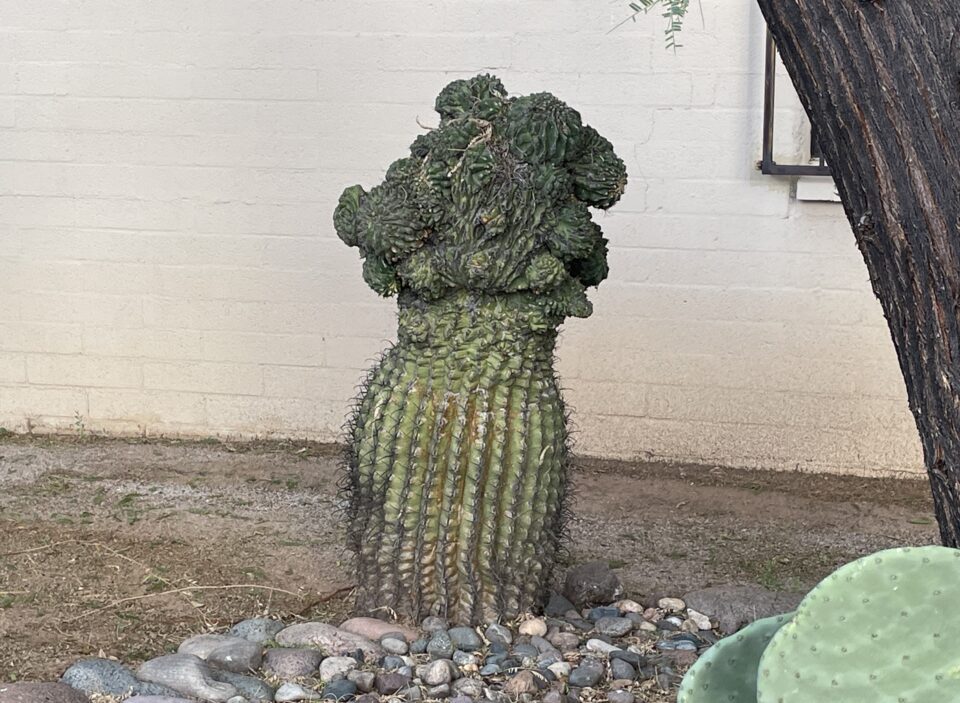
From the tourist pamphlets in the office, I learned of two places that I would have liked to visit near Tucson – the Kitt Peak National Observatory and Biosphere 2. Last night, if we had had internet and been able to research properly, I might have known to go there after the JCC instead of driving towards Nogalas. To avoid this happening again, we selected this campground because they promised Wifi. As we soon learned, not all promises are met, and we found ourselves once again not being able to search the internet and therefore not being able to plan properly for the next day.
In spite of the nice spontaneous nature walk this morning, planning everything ahead was looking better and better.
